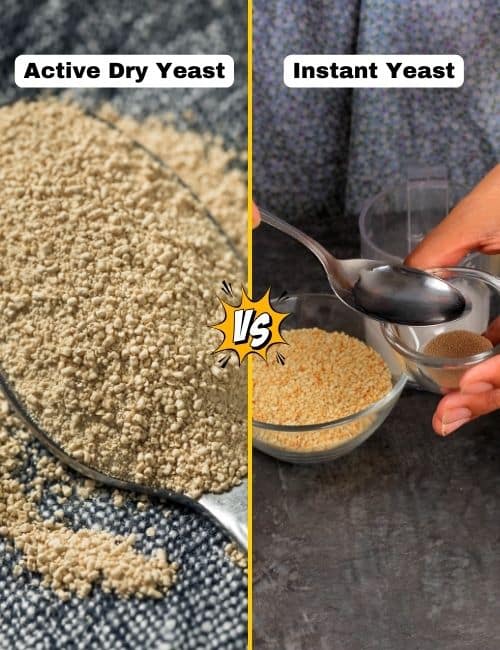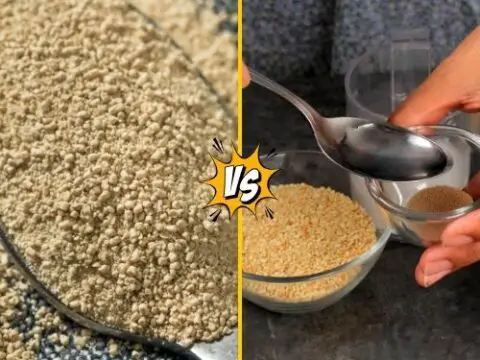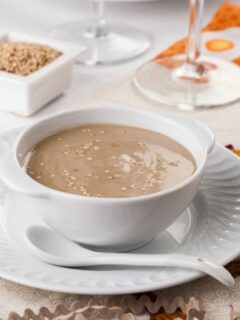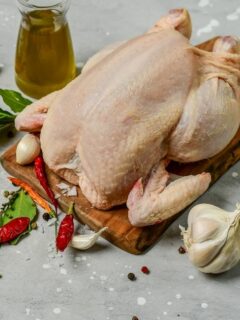Have you ever thought about the little ingredients that make bread rise and pizza dough puff up? We are talking about yeast. But guess what?
There are two most popular types of yeast in baking which are Active Dry Yeast and Instant Yeast. Do you know the difference between active dry yeast and instant yeast?
This guide will explain the Active Dry Yeast vs Instant Yeast and how to use yeast, how to buy yeast. It also includes FAQs and troubleshooting tips. Ready to learn? Let’s dive in.

Table of Contents
What is Yeast?
Yeast is a tiny seed like living thing you use in baking to make bread rise and become fluffy. Yeast reacts with sugar and sometimes a dash of warm water turns it into bubbles.
This bubbles help your dough to grow big and your bread becomes soft and yummy.
What are the different types of Yeast
Yeast comes in different forms each with its own uses for baking. Here are various types you want to know:
Active Dry Yeast:
- This yeast is like tiny sleepy beads. They need some warm water and sugar to wake up before helping your dough rise.
- Great for traditional recipes and bread.
Instant Yeast:
- Instant yeast is always awake and ready to go without using warm water.
- It is a perfect choice who are in a hurry and want your dough to rise quickly.
Fresh Yeast:
- Fresh yeast is soft and squishy. It is a bit trickier to find but can give your bread a special, fluffy texture.
- You need to use it faster because it doesn’t stay fresh for as long as dry yeast.
Osmotolerant Yeast:
- Osmotolerant yeast is like the water loving yeast. It can handle recipes with lots of sugar or salt which may slow down other yeasts.
- Handy for sweet bread and salty pretzels.
How to buy Yeast?
When you want to buy yeast look for the below categories.
Look for the Right Kind:
First, check your recipe to see what kind of yeast it needs. It may ask for active dry yeast or instant yeast. Make sure you get the one your recipe wants.
Check the Freshness:
Look at the package and find the ” use by ” date. You want a yeast that is still fresh and full of life.
No Clumps:
Make sure the yeast inside the package is not all clumpy. It should be nice and powdery, like flour. Clumps mean the yeast might not work as well.
Package Size:
Think about how much yeast you need. Some recipes ask for just a little while others need more. Get the right size so you don’t have too much or too little.
What are the differences between Active Dry and Instant Yeast
There are a few differences between Active Dry Yeast and Instant Yeast.
Remember, the yeast you choose depends on your recipe and how much time you have. Here are a few points about their difference.
Activation: Active Dry Yeast needs a warm bath with sugar to wake up before using. But, instant Yeast is always ready to use no bath is needed.
Time: Active Dry Yeast takes a bit longer to make the dough rise. But, Instant Yeast works faster to raise the dough.
Storage: Active Dry Yeast can sit on your shelf for a long time. Whereas, Instant Yeast prefers the fridge to stay fresh.
Recipes: Active Dry Yeast is great for traditional recipes. But, Instant Yeast is perfect for when you are in a hurry.
How to use Yeast
You can use yeast to make delicious bread, pizza or whatever tasty treat you are baking. Remember, yeast likes warm water and a bit of sugar to wake up and it needs time to make your dough rise.
Prepare Your Ingredients:
You will need yeast, warm water and a little bit of sugar to wake up the yeast. You can also follow your recipe to decide how much yeast you need.
Activate the Yeast:
Now, put the yeast in a bowl and add the warm water and sugar. Make sure, the water is warm but not too hot.
Stir everything together gently and let it sit for about 5-10 minutes. You’ll know it’s ready when it gets all foamy and bubbly. This means the yeast is awake and ready to work its magic!
Mix it In:
Now, you can add your yeast mixture to the rest of your recipe ingredients like flour, salt, and some oil or butter.
Mix everything together until you have a nice, doughy mixture.
Let it Rise:
Cover your dough and let it rest for an hour or you can follow your recipe instructions. This is where the yeast helps to the dough rise.
Bake It:
Once your dough has doubled in size, it is the perfect time to bake it in the oven. Follow your recipe for the right temperature and time.
You May Like
Expert tips and tricks using yeast
Pre-soak the Yeast:
Before adding yeast to your recipe you can give it a head start by mixing it with warm water and a pinch of sugar. This helps it wake up faster and work its magic sooner.
Yeast-to-Water Ratios:
Experiment with the amount of yeast you use. More yeast makes the dough rise faster while less yeast can give a unique, slow-rise flavor.
Use Milk Instead Of Water :
If your recipe calls for water, try using milk instead. Milk makes your bread softer and adds a hint of sweetness.
Knead It Right:
When you are kneading your dough that’s when you squish and fold it, do it for about 10-15 minutes. It helps the dough become stretchy and soft.
Let It Rest:
After baking, let your bread cool down a bit before cutting into it. This helps keep it from getting too squished and lets the flavours settle.
How to Store Yeast
You can safely store yeast for a longer duration without affecting its quality. Here is how you can do it.
Find a Safe Spot:
You need to store yeast in a cool and dry place. Make sure it is away from direct moisture and heat or sunlight.
Seal the Packet:
Once you open the yeast package make sure to seal it up tightly. So, it will last longer without affecting external influence.
Check the Date:
Look at the package for an expiry date. This tells you how long your yeast buddies will stay fresh and ready for action.
FAQs about Yeast Selection
Can I substitute instant yeast for active dry yeast or vice versa?
Yes, you can substitute them for each other. Remember that instant yeast works faster than active dry yeast. So use a bit less if you are swapping it for active dry yeast.
Does the type of yeast affect the taste of the final product?
Yes, it can. Active dry yeast may give your bread a different flavour because it takes time to rise the dough.
What happens if I accidentally use the wrong type of yeast?
Don’t worry. Your baking will still be delicious but the rising time might change a bit. Just follow the recipe’s advice.
My dough isn’t rising. What did I do wrong?
Maybe your water was too hot or too cold during proofing. Yeast likes it warm but not scalding.
How can I activate active dry yeast properly?
Give it some lukewarm water and a pinch of sugar and wait for it to get all bubbly and excited.
Why did my bread turn out with a yeasty flavor?
Using too much yeast or not giving your dough enough rising time might make it taste yeasty. Try adjusting these next time.
Active dry yeast and instant yeast are different but they are both important in baking. They each have their own characteristics. Now you know how to use them.
If you like to take your time baking or want fast results, these yeasts can help you in the kitchen. So, grab your favorite yeast and start baking some delicious treats.
Active Dry Yeast vs Instant Yeast : What's the difference

Discover the baking secrets: Active Dry Yeast vs. Instant Yeast.
Find out the differences between them for perfect dough every time. Which yeast
suits your recipe best? Are you ready to learn? Let's start?
Ingredients
- Active Dry Yeast
- Instant Yeast
Instructions
Active Dry Yeast vs Instant Yeast : What's the difference
- Read all of the above instructions carefully about types of yeast.
- It also describes the difference between active dry yeast and instant yeast.
- Apart from that learn how to buy yeast, how to store yeast and how to use yeast.






